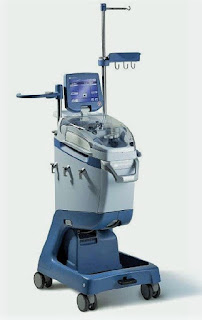Cell (Blood) Salvage
Definition:
-Cell (blood) salvage
is a process in which a patient’s own (lost) blood is collected, processed, and
transfused back (‘Autologous’ blood transfusion), which is done by a cell saver machine.
Principle:
1-Collection of
blood: blood is suctioned from the operative field, and then heparinized saline is
added, filtered, and centrifuged to separate RBCs which are then washed.
2-Washing of
RBCs: across a semi-permeable membrane to filter out free Hb, plasma, WBCs, and
platelets.
3-Re-transfusion:
Washed RBCs are then suspended in saline (to achieve Hct of 60-70%) and
transfused within 6 hours.
Advantages:
-Reduce or
eliminate the need for ‘allogenic’ transfusion.
-‘Allogenic’
blood transfusion has been associated with an increased risk of postoperative
infection, acute lung injury, perioperative MI, low CO HF, and tumor recurrence.
Indications:
-Anticipated
blood loss >1L or >20% of estimated blood volume
-Patients with
low Hb, multiple RBCs alloantibodies, rare blood group, and patient refusal of ‘allogenic’
blood transfusion
-Obstetrics: Controversial
due to potential risk of amniotic fluid embolism. However; cell salvage with a Leucocyte-depletion filter (LDF) is considered safe
-Orthopedics: Reduce
‘allogenic’ transfusion & postoperative infection in arthroplasty
-Cardiac
surgery: Leucocyte-depletion filter (LDF) use, reduce micro-emboli & lipid
load of cell salvaged blood with an improvement of postoperative lung function.
-Vascular
surgery
-Liver
transplantation
-Jehovah’s
Witness
Contraindications:
-Malignancy: due to risk
of tumor dissemination
-Wound
contamination: due to risk of systemic spread
-Old hemolyzed blood
-Use of collagen or hemostatic
materials
-Obstetric surgery: due to risk of amniotic fluid embolism
-Ascites
Complications:
-Non-immune
hemolysis: due to centrifugation
-Coagulopathy: due
to large volumes of transfusion
-Citrate
overdosage
-Air embolism
-Febrile non-hemolytic
transfusion reaction
-Contamination: due to incomplete washing leading to contamination with drugs, activated leukocytes,
cytokines, and microaggregates.

























